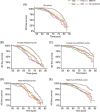Multisystem failure, tipping points, and risk of Alzheimer's disease
- PMID: 40346724
- PMCID: PMC12064414
- DOI: 10.1002/alz.70249
Multisystem failure, tipping points, and risk of Alzheimer's disease
Abstract
Introduction: Medical conditions including obesity, diabetes, hyperlipidemia, and depression significantly increased risk of Alzheimer's disease (AD). However, effect of their duration, influenced by non-modifiable factors like chromosomal sex and apolipoprotein E (APOE) genotype, remains unclear.
Methods: Data from 5644 UKBiobank participants were analyzed using Cox regression model to identify critical tipping points based on age of onset, risk factor (RF) duration and their interaction with sex and APOE genotype.
Results: Hypertension or diabetes before age 62 exerted greater AD risk than APOEε4 alone. Obesity before age 62 increased AD risk by 54%, with the risk nearly tripling between ages 62-72. Hyperlipidemia and depression were associated with age-independent risk increases of 33% and 69%, respectively. After age 72, APOEε4 became the dominant RF.
Discussion: Duration of AD-risk-factors can have a greater impact than APOEε4. Identification of critical age-related tipping points highlights temporal dynamics of AD progression and role of multisystem failure in AD progression.
Highlights: AD risk factors impact AD onset, especially diagnosed between ages 62 and 72. Later diagnoses of hypertension, diabetes, and obesity delayed AD onset. Hyperlipidemia and depression increased AD risk by 33% and 69%, age-independent. APOEε4 carriers regardless of sex exhibited a higher risk increasing with age. Trajectories differed between APOEε4 carriers and non-carriers across sex.
Keywords: AD prevention strategies; AD‐risk‐factors; APOE genotype; Alzheimer's disease (AD); Cox proportional hazard model (CPHM); UK Biobank; chromosomal sex; depression; hyperlipidemia (HLP); hypertension (HTN); late onset Alzheimer's disease (LOAD); modifiable risk factors; obesity; type 2 diabetes (T2D); unmodifiable risk factors.
© 2025 The Author(s). Alzheimer's & Dementia published by Wiley Periodicals LLC on behalf of Alzheimer's Association.
Conflict of interest statement
Authors declare no competing interests. Author disclosures are available in the Supporting Information.
Figures




References
-
- van Dyck CH, Swanson CJ, Aisen P, et al. Lecanemab in Early Alzheimer's Disease. N Engl J Med. 2022;388:9‐21. - PubMed
-
- Budd Haeberlein S, Aisen PS, Barkhof F, et al. Two randomized phase 3 studies of aducanumab in early Alzheimer's disease. The J Prevention of Alzheimers Dis. 2022;9:197‐210. - PubMed
MeSH terms
Substances
Grants and funding
- 5R01AG057931-02 [Sex Differences in Molecular Dementias of Alzheimer's Disease Risk: Prodromal Endophenotype]/AG/NIA NIH HHS/United States
- R01 AG057931/AG/NIA NIH HHS/United States
- P01 AG026572/AG/NIA NIH HHS/United States
- P01AG026572 [Perimenopause in Brain Aging and Alzheimer's Disease]/AG/NIA NIH HHS/United States
- Women's Alzheimer's Movement to Roberta Diaz Brinton
LinkOut - more resources
Full Text Sources
Medical
Miscellaneous

